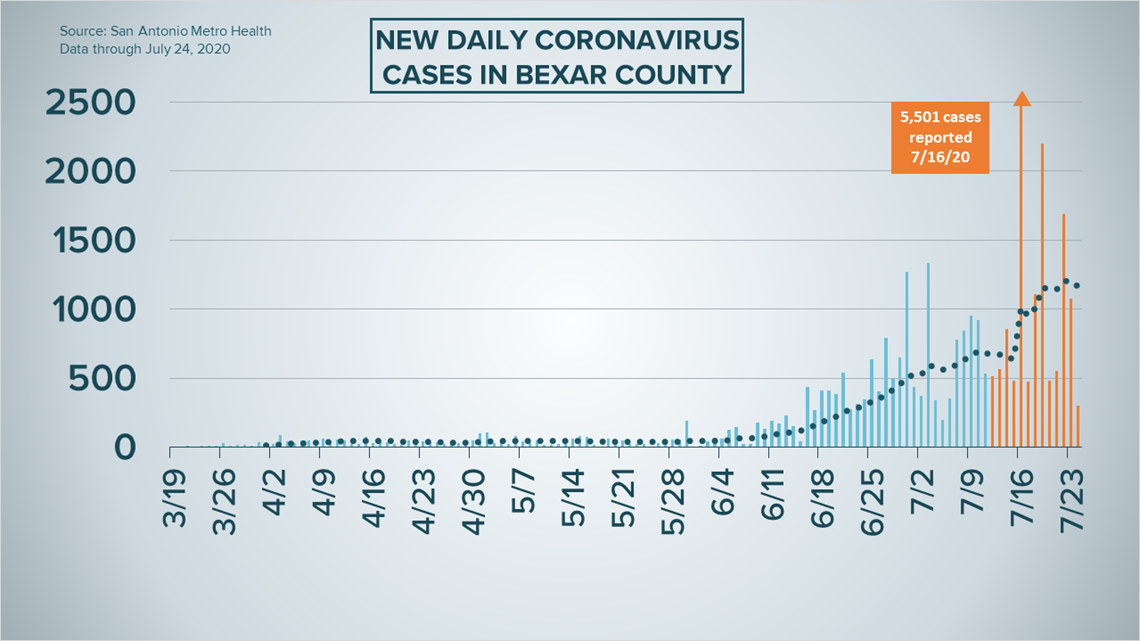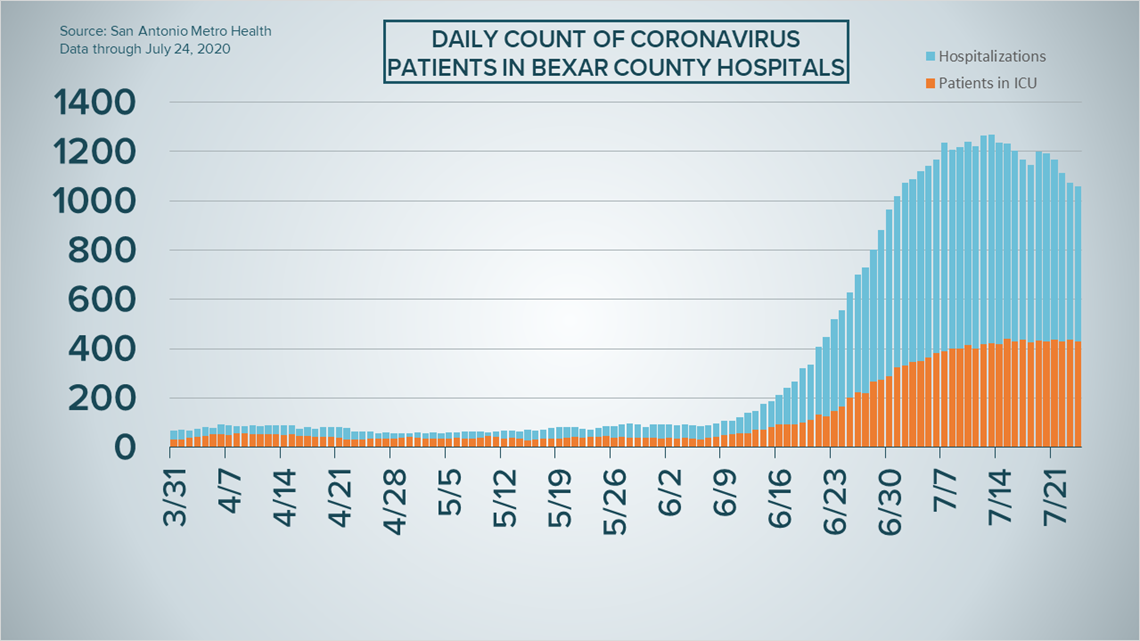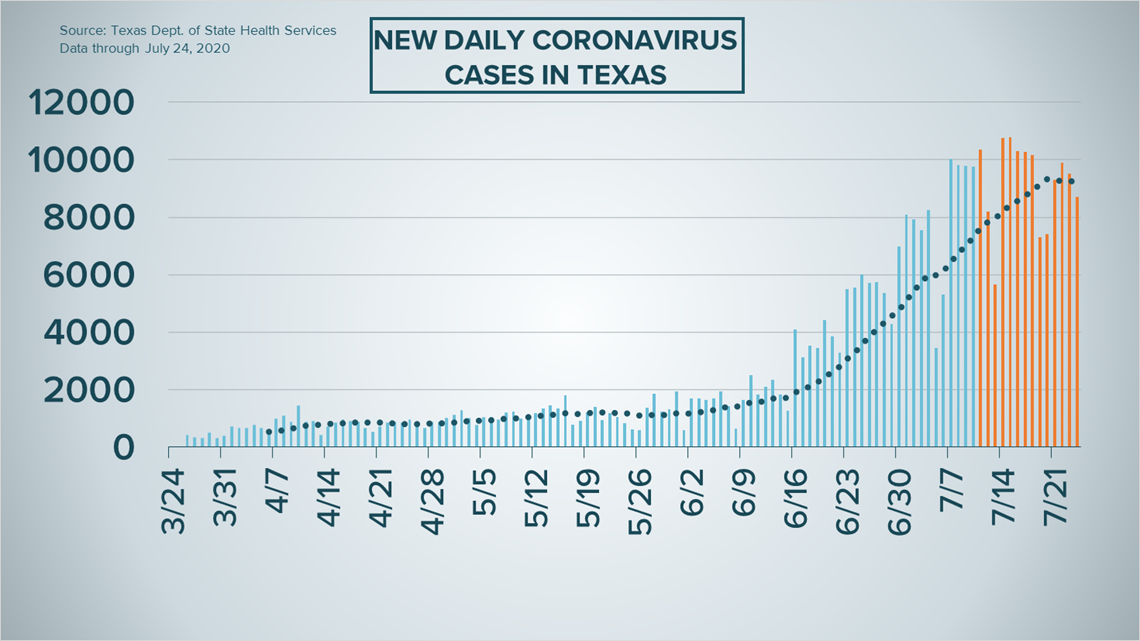SAN ANTONIO — We're tracking the latest numbers from the coronavirus pandemic in San Antonio and across Texas. Here are the latest numbers reported by Bexar and surrounding counties:
- Bexar County: 299 new cases and 15 additional fatalities from COVID-19 were reported Friday. There have been a total of 34,932 cases and 313 virus-related fatalities in the county.
- Comal County: The county reported 88 new cases on Saturday. Officials also confirmed the county's 45th death. There have been a total of 1,968 cases.
- Hays County: The county reported 42 new cases and a pair additional virus-related deaths on Friday. In all, 4,133 cases of COVID-19 have been confirmed in the county; 2,977 of those cases are considered active. The death toll is up to 24.
How Bexar County is trending
We're tracking how many coronavirus cases are confirmed in Bexar County each day from the time San Antonio Metro Health began reporting cases more than two months ago. Graphing those daily case numbers along a 14-day moving average provides an accurate picture of the curve in the San Antonio area and the direction we're heading amid the coronavirus.
On Friday, Mayor Ron Nirenberg reported 299 new cases of the novel coronavirus in Bexar County, a sharp drop from the totals of 1,688 and 1,078 on Wednesday and Thursday, respectively. The county has confirmed 34,932 total cases of the virus in the ongoing pandemic.


While the number of cases went down, Nirenberg reported 15 additional deaths from virus-related complications for the second straight day. In all, 313 Bexar County residents have now died from COVID-19.


Hospitalizations continued to trend in a positive direction, with the number of those receiving treatment at county hospitals going down for the fifth straight day. Entering the weekend, 1,059 were hospitalized with COVID-19, while 430 were in intensive care and 294 were utilizing ventilators.


Coronavirus in Texas
State health officials on Friday reported another 8,701 confirmed cases of the novel coronavirus, bringing the state total to 369,826. Just twice in the last week did Texas reported a lower daily total of new cases.


As death rates from coronavirus complications rise, the state also reported its second-highest daily total of additional fatalities on Friday, with 196. Each of the last three has seen at least 173 deaths; there was just one such day during the first few months of the pandemic prior to Wednesday.
The statewide death toll has now reached 4,717.


For the second straight day, Texas says it's reporting incomplete hospitalizations data. The Department of State Health Services reported that 10,036 Texans are receiving treatment for COVID-19, but that represents information provided by just 90% of hospitals in the state.
Here is the department's full disclaimer:
"DSHS is reporting incomplete hospitalization numbers today due to a transition in reporting to comply with new federal requirements. For July 24, 90 percent of hospitals reported complete data to DSHS, resulting in a partial data set and the appearance of a drop in hospitalizations. DSHS continues to work with Texas hospitals during this transition to ensure all facilities can fully report the data required."
Latest Coronavirus Headlines
- SAISD special education teacher dies of coronavirus
- San Antonio hospitals to be reinforced by Texas, federal military aid
- National Guard to help manage portable morgues as deaths mount in Rio Grande Valley
- McDonald's to require face masks starting in August
- Texans urged to stop spreading misinformation about COVID-19 on social media
- Nonprofits that rely on Wurstfest left looking for other fundraising options
- Here's what Bexar Co. deputies are looking for as they stop by businesses to enforce local mask orders
- Fauci says he wouldn't fly or eat out amid the coronavirus pandemic
- CDC releases 'Decision-Making Tool' for parents in school reopening guidance
- Freestanding emergency rooms play important role in coronavirus pandemic
Coronavirus symptoms
The symptoms of coronavirus can be similar to the flu or a bad cold. Symptoms include fever or chills, cough, shortness of breath or difficulty breathing, fatigue, muscle or body aches, headache, new loss of taste or smell sore throat, congestion or runny nose, nausea or vomiting and diarrhea, according to the Centers for Disease Control.
Most healthy people will have mild symptoms. A study of more than 72,000 patients by the Centers for Disease Control in China showed 80 percent of the cases there were mild.
But infections can cause pneumonia, severe acute respiratory syndrome, kidney failure, and even death, according to the World Health Organization. Older people with underlying health conditions are most at risk.
On June 25, the CDC expanded the list of groups at a higher risk of severe illness due to coronavirus.
Experts determined there was consistent evidence these conditions increase a person's risk, regardless of age:
- Chronic kidney disease
- COPD (chronic obstructive pulmonary disease)
- Obesity (BMI of 30 or higher)
- Immunocompromised state (weakened immune system) from solid organ transplant
- Serious heart conditions, such as heart failure, coronary artery disease, or cardiomyopathies
- Sickle cell disease
- Type 2 diabetes
The CDC believes symptoms may appear anywhere from two to 14 days after being exposed.
Human coronaviruses are usually spread...
- Between people who are in close contact with one another (within about 6 feet).
- Through respiratory droplets produced when an infected person coughs, sneezes or talks. These droplets can land in the mouths or noses of people who are nearby or possibly be inhaled into the lungs.
- Some recent studies have suggested that COVID-19 may be spread by people who are not showing symptoms.
Help stop the spread of coronavirus
- Stay home when you are sick.
- Eat and sleep separately from your family members
- Use different utensils and dishes
- Cover your cough or sneeze with your arm, not your hand.
- If you use a tissue, throw it in the trash.
Lower your risk
- Wash your hands often with soap and water for at least 20 seconds. If soap and water are not available, use an alcohol-based hand sanitizer.
- Avoid touching your eyes, nose, and mouth with unwashed hands.
- Avoid close contact with people who are sick.
- Clean and disinfect frequently touched objects and surfaces.
- The CDC recommends wearing a mask or cloth face covering if you have to be out due to an essential service or essential activity such as going to the grocery store.
- If you are 60 or over and have an underlying health condition such as cardiovascular disease, diabetes or respiratory illnesses like asthma or COPD, the World Health Organization advises you to try to avoid crowds or places where you might interact with people who are sick.

